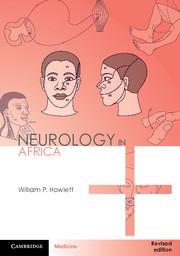Book contents
- Frontmatter
- Dedication
- Contents
- PREFACE
- Acknowledgments
- Part II Neurological Disorders
- 3 Public Health
- 4 Epilepsy
- 5 Stroke
- 6 Neurological Infections
- 7 Protozoal Andhelminthic Infections
- 8 Neurological Illness in HIV Disease
- 9 Coma and Transient Loss of Consciousness
- 10 Paraplegia Non Traumatic
- 11 Disorders of Peripheral Nerves
- 12 Cranial Nerve Disorders
- 13 Myopathies and Myasthenia Gravis
- 14 Movement Disorders and Motor Neurone Disease
- 15 Headache and Facial Pain
- 16 Intracranial Tumours
- 17 Dementia
- 18 Inherited Neurological Disorders
- 19 Head and Spinal Injury
- 20 Care in Neurology
- INDEX
- ABBREVIATIONS
- USEFUL WEBSITES
13 - Myopathies and Myasthenia Gravis
from Part II - Neurological Disorders
- Frontmatter
- Dedication
- Contents
- PREFACE
- Acknowledgments
- Part II Neurological Disorders
- 3 Public Health
- 4 Epilepsy
- 5 Stroke
- 6 Neurological Infections
- 7 Protozoal Andhelminthic Infections
- 8 Neurological Illness in HIV Disease
- 9 Coma and Transient Loss of Consciousness
- 10 Paraplegia Non Traumatic
- 11 Disorders of Peripheral Nerves
- 12 Cranial Nerve Disorders
- 13 Myopathies and Myasthenia Gravis
- 14 Movement Disorders and Motor Neurone Disease
- 15 Headache and Facial Pain
- 16 Intracranial Tumours
- 17 Dementia
- 18 Inherited Neurological Disorders
- 19 Head and Spinal Injury
- 20 Care in Neurology
- INDEX
- ABBREVIATIONS
- USEFUL WEBSITES
Summary
Myopathies are classified as either inherited or acquired. The main inherited myopathies are muscular dystrophies and acquired myopathies are inflammatory and non inflammatory. The main disorder which affects the neuromuscular junction is myasthenia gravis (MG). The aim of this chapter is to review the clinical features and management of muscular dystrophy, polymyositis and MG. The student should aim to be able to recognize these main muscle disorders and manage a patient presenting with muscle weakness.
Clinical history
The defining symptom of disorders of muscle and neuromuscular junction is weakness. Muscle weakness in myopathy is usually proximal. Patients typically present with weakness or difficulty elevating their arms above the shoulders, getting out of chairs or rising from the lying position. Other symptoms may include muscle pain and tenderness, muscle cramps on exercise and dysphagia. The history should include age of onset, time course, pattern and distribution of weakness, fatigability and any relevant past, family and drug history. Muscular dystrophies tend to have their onset in childhood or teens and are usually recognizable clinically. Inflammatory myopathies present with proximal muscle weakness, frequently with muscle pain, tenderness and sometimes dysphagia. The diagnostic characteristic of myasthenia gravis is fatigable muscle weakness, worse after exercise and commonly affecting the extra ocular and bulbar muscles.
Physical Examination
The characteristic clinical finding in myopathies and MG is muscle weakness. The weakness affects mainly the trunk and proximal limb muscles, and may also affect the neck muscles and facial expression. Power distally may be maintained in early disease but is lost or decreased later on. Muscle wasting occurs in most myopathies, tone is typically decreased and reflexes are preserved but may be reduced or absent in advanced disease. There are no sensory signs. Patients with muscle disease often have a very characteristic myopathic or “waddling” gait due to hip girdle weakness. The pattern of muscle weakness may indicate the underlying disorder. Muscle psudohypertrophy confined to the calves in boys is diagnostic of dystrophy and contractures may occur in long standing disease. Weakness of the eye muscles suggests myasthenia gravis whereas weakness of the face muscles is more of a feature of facioscapulohumeral dystrophy and myotonic dystrophy. Weakness of the neck muscles is typical of myasthenia gravis and polymyositis. Proximal weakness in combination with a skin rash is characteristic of dermatomyositis.
- Type
- Chapter
- Information
- Neurology in AfricaClinical Skills and Neurological Disorders, pp. 309 - 326Publisher: Cambridge University PressPrint publication year: 2015



